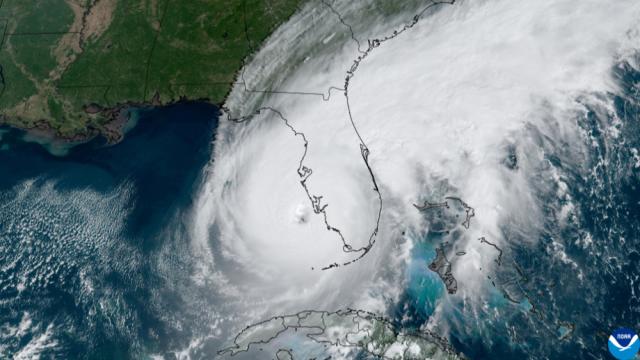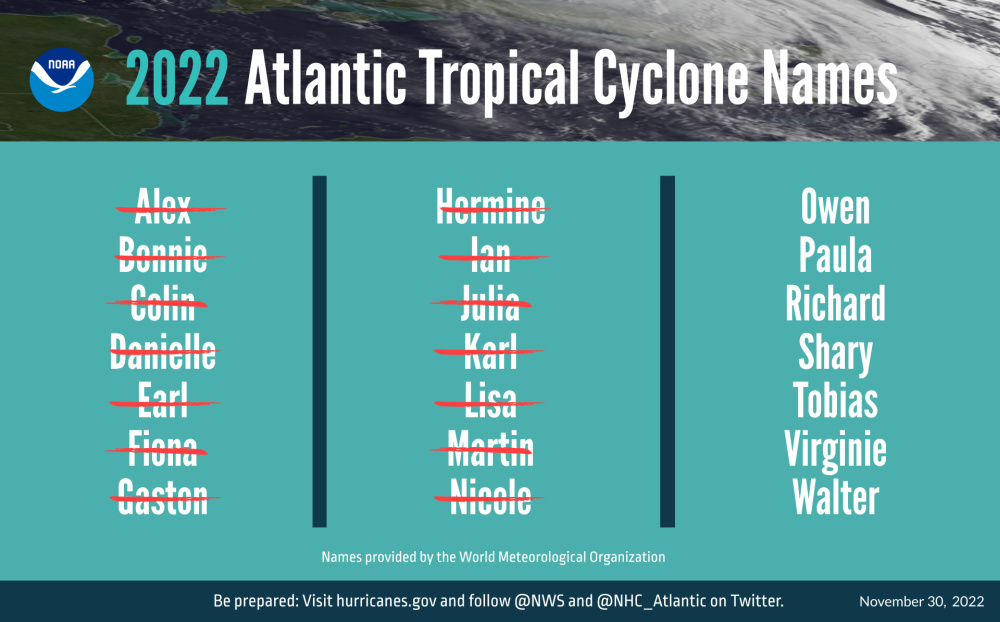
In total, this hurricane season produced 14 named storms (winds of 39 mph or greater), of which eight became hurricanes (winds of 74 mph or greater) and two intensified to major hurricanes with winds reaching 111 mph or greater. (Source: NOAA)
The 2022 Atlantic hurricane season officially ends on Nov. 30, producing a total of 14 named storms, eight of which became hurricanes, according to the National Oceanic and Atmospheric Administration (NOAA).
Despite the end of this year’s hurricane season, “the impact of Hurricanes Ian, Nicole and Fiona—which brought extensive damage to Florida’s coast and Puerto Rico, respectively—will continue to be felt long after the season is over,” the NOAA noted in a Nov. 29 release.
In total, this hurricane season produced 14 named storms (winds of 39 mph or greater), of which eight became hurricanes (winds of 74 mph or greater) and two intensified to major hurricanes with winds reaching 111 mph or greater. An average hurricane season has 14 named storms, seven hurricanes and three major hurricanes.

The 2022 season saw three hurricane landfalls along the coast of the U.S. mainland.
Hurricane Ian made landfall first as a Category 4 storm in Cayo Costa, Florida, and again as a Category 1 in Georgetown, South Carolina. As a Category 4 with 150 mph maximum sustained winds, Hurricane Ian tied for the fifth-strongest hurricane ever to make landfall in the U.S. Hurricane Nicole made landfall as a Category 1 in north Hutchinson Island, Florida.
Hurricane Fiona made landfall outside of the mainland U.S. as a Category 1 near Punta Tocon, Puerto Rico.
“I commend NOAA’s dedicated scientists, hurricane hunter pilots and forecasters who worked diligently to help American communities become hurricane resilient and climate-ready for the impacts of this hurricane season and the years to come,” said Secretary of Commerce Gina Raimondo.
The NOAA said the unique season this year was defined by a rare mid-season pause in storms that scientists preliminarily believe was caused by increased wind shear and suppressed atmospheric moisture high over the Atlantic Ocean.
After a quiet period in August, activity ramped up in September with seven named storms, including the two major hurricanes—Fiona and Ian—seen this season. The season also included a rare late-season storm with Hurricane Nicole making landfall on Nov. 10 along the east coast of Florida.
“Forecasters at NOAA’s National Weather Service and its National Hurricane Center issued earlier forecasts with increasing accuracy this season,” said NOAA Administrator Rick Spinrad, Ph.D. “These improved forecasts coupled with critical NOAA data and services undoubtedly led to the better protection of life and property.”
The 2023 hurricane season will officially begin on June 1. NOAA’s Climate Prediction Center, a division of the National Weather Service, will issue its initial 2023 seasonal outlook in May.
Recommended Reading
Baker Hughes Awarded Saudi Pipeline Technology Contract
2024-04-23 - Baker Hughes will supply centrifugal compressors for Saudi Arabia’s new pipeline system, which aims to increase gas distribution across the kingdom and reduce carbon emissions
PrairieSky Adds $6.4MM in Mannville Royalty Interests, Reduces Debt
2024-04-23 - PrairieSky Royalty said the acquisition was funded with excess earnings from the CA$83 million (US$60.75 million) generated from operations.
Equitrans Midstream Announces Quarterly Dividends
2024-04-23 - Equitrans' dividends will be paid on May 15 to all applicable ETRN shareholders of record at the close of business on May 7.
SLB’s ChampionX Acquisition Key to Production Recovery Market
2024-04-21 - During a quarterly earnings call, SLB CEO Olivier Le Peuch highlighted the production recovery market as a key part of the company’s growth strategy.
PHX Minerals’ Borrowing Base Reaffirmed
2024-04-19 - PHX Minerals said the company’s credit facility was extended through Sept. 1, 2028.





